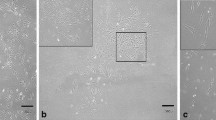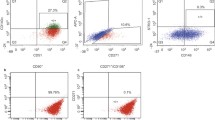Abstract
Objectives
It is well accepted that stage-specific embryonic antigen (SSEA)-4 is an antigen that is useful to isolate adult stem cells analogous to embryonic stem cells. Therefore, in the present study, we investigated whether SSEA-4 can also be used as a marker to identify human deciduous dental pulp (D-DP) stem cells.
Materials and methods
Intact deciduous teeth were collected from healthy patients who were undergoing orthodontic treatment at Okayama University Hospital. Immunofluorescence analysis, flow cytometric analysis, and multilineage differentiation assay were performed to characterize SSEA-4+ D-DP cells.
Results
The D-DP cells had the characteristics of mesenchymal stem cells (MSCs), namely plastic adherence, specific surface antigen expression, and multipotent differentiation potential. SSEA-4 expression was detected in D-DP cells in vitro and ex vivo samples. A flow cytometric analysis demonstrated that 21.2 % of the D-DP cells were positive for SSEA-4. The SSEA-4+ clonal D-DP cells showed multilineage differentiation potential toward adipocytes, osteoblasts, and chondrocytes in vitro. In fact, 26.1 % (6/23) of the SSEA-4+ clonal D-DP cells showed adipogenic potential, 91.3 % (21/23) showed osteogenic potential, 91.3 % (21/23) showed chondrogenic potential, and 87.0 % (20/23) showed both osteogenic and chondrogenic potential.
Conclusions
Thus, the majority of SSEA-4+ D-DP cells had the potential for multilineage differentiation. Hence, SSEA-4 appears to be a specific marker that can be used to identify D-DP stem cells.
Clinical relevance
SSEA-4+ D-DP cells appear to be a promising source of stem cells for regenerative therapy.




Similar content being viewed by others
References
Yanagisawa M (2011) Stem cell glycolipids. Neurochem Res 36(9):1623–1635. doi:10.1007/s11064-010-0358-1
Telles PD, Machado MA, Sakai VT, Nör JE (2011) Pulp tissue from primary teeth: new source of stem cells. J Appl Oral Sci 19(3):189–194
National institutes of Health, Department of Health and Human Services (2001) Stem cells: scientific progress and future research directions. http://stemcells.nih.gov/info/2001report/2001report.htm. Accessed 18 July 2013
Chang H, Knothe Tate ML (2012) Concise review: the periosteum: tapping into a reservoir of clinically useful progenitor cells. Stem Cells Transl Med 1(6):480–491. doi:10.5966/sctm.2011-0056
Gronthos S, Mankani M, Brahim J, Robey PG, Shi S (2000) Postnatal human dental pulp stem cells (DPSCs) in vitro and in vivo. Proc Natl Acad Sci U S A 97(25):13625–13630
Seo BM, Miura M, Gronthos S, Bartold PM, Batouli S, Brahim J, Young M, Robey PG, Wang CY, Shi S (2004) Investigation of multipotent postnatal stem cells from human periodontal ligament. Lancet 364(9429):149–155
Kawanabe N, Murakami K, Takano-Yamamoto T (2006) The presence of ABCG2-dependent side population cells in human periodontal ligaments. Biochem Biophys Res Commun 344(4):1278–1283
Kawanabe N, Murata S, Murakami K, Ishihara Y, Hayano S, Kurosaka H, Kamioka H, Takano-Yamamoto T, Yamashiro T (2010) Isolation of multipotent stem cells in human periodontal ligament using stage-specific embryonic antigen-4. Differentiation 79(2):74–83. doi:10.1016/j.diff.2009.10.005
Kawanabe N, Murata S, Fukushima H, Ishihara Y, Yanagita T, Yanagita E, Ono M, Kurosaka H, Kamioka H, Itoh T, Kuboki T, Yamashiro T (2012) Stage-specific embryonic antigen-4 identifies human dental pulp stem cells. Exp Cell Res 318(5):453–463. doi:10.1016/j.yexcr.2012.01.008
Miura M, Gronthos S, Zhao M, Lu B, Fisher LW, Robey PG, Shi S (2003) SHED: stem cells from human exfoliated deciduous teeth. Proc Natl Acad Sci U S A 100(10):5807–5812
Silvério KG, Rodrigues TL, Coletta RD, Benevides L, Da Silva JS, Casati MZ, Sallum EA, Nociti FH Jr (2010) Mesenchymal stem cell properties of periodontal ligament cells from deciduous and permanent teeth. J Periodontol 81(8):1207–1215. doi:10.1902/jop.2010.090729
Fukushima H, Kawanabe N, Murata S, Ishihara Y, Yanagita T, Balam TA, Yamashiro T (2012) SSEA-4 is a marker of human deciduous periodontal ligament stem cells. J Dent Res 91(10):955–960
Simmons PJ, Torok-Storb B (1991) Identification of stromal cell precursors in human bone marrow by a novel monoclonal antibody, STRO-1. Blood 78(1):55–62
Colter DC, Sekiya I, Prockop DJ (2001) Identification of a subpopulation of rapidly self-renewing and multipotential adult stem cells in colonies of human marrow stromal cells. Proc Natl Acad Sci U S A 98(14):7841–7845
Trubiani O, Di Primio R, Traini T, Pizzicannella J, Scarano A, Piattelli A, Caputi S (2005) Morphological and cytofluorimetric analysis of adult mesenchymal stem cells expanded ex vivo from periodontal ligament. Int J Immunopathol Pharmacol 18(2):213–221
Muraglia A, Cancedda R, Quarto R (2000) Clonal mesenchymal progenitors from human bone marrow differentiate in vitro according to a hierarchical model. J Cell Sci 113(Pt 7):1161–1166
Dominici M, Le Blanc K, Mueller I, Slaper-Cortenbach I, Marini F, Krause D, Deans R, Keating A, Prockop DJ, Horwitz E (2006) Minimal criteria for defining multipotent mesenchymal stromal cells. The International Society for Cellular Therapy position statement. Cytotherapy 8(4):315–317
Pittenger MF, Mackay AM, Beck SC, Jaiswal RK, Douglas R, Mosca JD, Moorman MA, Simonetti DW, Craig S, Marshak DR (1999) Multilineage potential of adult human mesenchymal stem cells. Science 284(5411):143–147
Bevilacqua MP, Pober JS, Mendrick DL, Cotran RS, Gimbrone MA Jr (1987) Identification of an inducible endothelial-leukocyte adhesion molecule. Proc Natl Acad Sci U S A 84(24):9238–9242
Jubeli E, Moine L, Vergnaud-Gauduchon J, Barratt G (2012) E-selectin as a target for drug delivery and molecular imaging. J Control Release 158(2):194–206. doi:10.1016/j.jconrel.2011.09.084
Miettinen M, Sarlomo-Rikala M, Lasota J (2000) KIT expression in angiosarcomas and fetal endothelial cells: lack of mutations of exon 11 and exon 17 of C-kit. Mod Pathol 13(5):536–541
Sakai VT, Zhang Z, Dong Z, Neiva KG, Machado MA, Shi S, Santos CF, Nör JE (2010) SHED differentiate into functional odontoblasts and endothelium. J Dent Res 89(8):791–796. doi:10.1177/0022034510368647
Shi S, Gronthos S (2003) Perivascular niche of postnatal mesenchymal stem cells in human bone marrow and dental pulp. J Bone Miner Res 18(4):696–704
Gang EJ, Bosnakovski D, Figueiredo CA, Visser JW, Perlingeiro RC (2007) SSEA-4 identifies mesenchymal stem cells from bone marrow. Blood 109(4):1743–1751
Yen BL, Huang HI, Chien CC, Jui HY, Ko BS, Yao M, Shun CT, Yen ML, Lee MC, Chen YC (2005) Isolation of multipotent cells from human term placenta. Stem Cells 23(1):3–9
Maddox JR, Ludlow KD, Li F, Niyibizi C (2012) Breast and abdominal adipose multipotent mesenchymal stromal cells and stage-specific embryonic antigen 4 expression. Cells Tissues Organs 196(2):107–116. doi:10.1159/000331332
Kerkis I, Kerkis A, Dozortsev D, Stukart-Parsons GC, Gomes Massironi SM, Pereira LV, Caplan AI, Cerruti HF (2006) Isolation and characterization of a population of immature dental pulp stem cells expressing OCT-4 and other embryonic stem cell markers. Cells Tissues Organs 184(3–4):105–116
Thomson JA, Itskovitz-Eldor J, Shapiro SS, Waknitz MA, Swiergiel JJ, Marshall VS, Jones JM (1998) Embryonic stem cell lines derived from human blastocysts. Science 282(5391):1145–1147
Takahashi K, Tanabe K, Ohnuki M, Narita M, Ichisaka T, Tomoda K, Yamanaka S (2007) Induction of pluripotent stem cells from adult human fibroblasts by defined factors. Cell 131(5):861–872
Brimble SN, Sherrer ES, Uhl EW, Wang E, Kelly S, Merrill AH Jr, Robins AJ, Schulz TC (2007) The cell surface glycosphingolipids SSEA-3 and SSEA-4 are not essential for human ESC pluripotency. Stem Cells 25(1):54–62
Acknowledgments
The present study was supported by Grants-in-Aid for Scientific Research (to N. Kawanabe [24593091] and T. Yamashiro [24249093]) from the Japan Society for the Promotion of Science, Japan.
Author contribution
N. Kawanabe contributed to the conception and design of the study, obtaining financial support for the study, the collection and/or assembly of the data, the data analysis and interpretation, the writing of the manuscript, and the final approval of the manuscript. H. Fukushima contributed to the conception and design of the study, the collection and/or assembly of the data, the data analysis and interpretation, and the writing of the manuscript. Y. Ishihara performed the confocal laser microscopic analysis. T. Yamashiro contributed to the conception and design of the study, obtaining financial support, the data analysis and interpretation, and the writing of the manuscript.
Conflict of interest
The authors declare no potential conflicts of interest with respect to the authorship and/or publication of this article.
Author information
Authors and Affiliations
Corresponding author
Rights and permissions
About this article
Cite this article
Kawanabe, N., Fukushima, H., Ishihara, Y. et al. Isolation and characterization of SSEA-4-positive subpopulation of human deciduous dental pulp cells. Clin Oral Invest 19, 363–371 (2015). https://doi.org/10.1007/s00784-014-1260-z
Received:
Accepted:
Published:
Issue Date:
DOI: https://doi.org/10.1007/s00784-014-1260-z




